Sequence Models
Sequence data 指的是一連串的 data,例如輸入 input 一連串聲音 output 成文字(語音識別),我們要利用 Recurrent Neural Network (循環神經網路) 來建立出 sequence model。
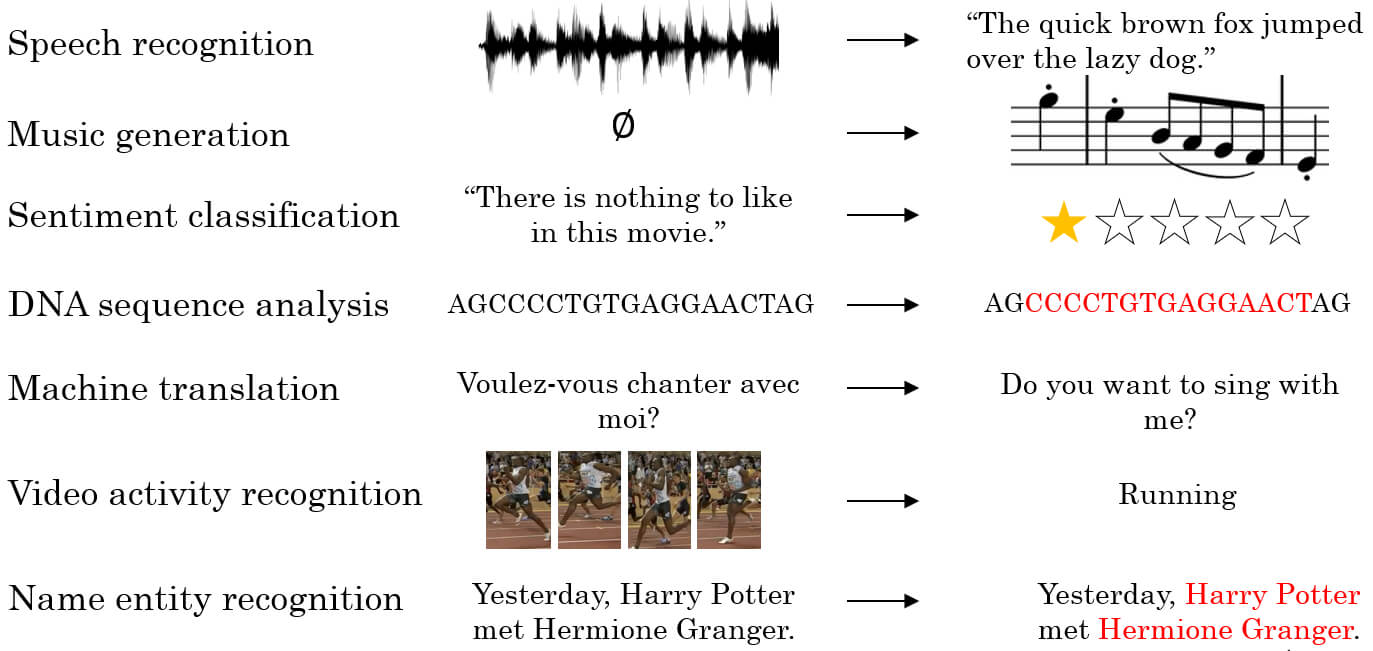
Notation
假設有一個 name entity recognition 案例,要標示出所有的人名
句子中每個字依照順序會標註成
因為 y 跟 x 的字一模一樣,所以用 1 標示是要找的人名
另外 表示句子的字數,同樣方式表達 y 的字數 。因為可能有多筆 training set,若要表示第 i 筆 data 的第 t 個字可以寫成 ;表達字數的方式也差不多: 。
Vocabulary (Dictionary)
通常我們會用一整個列表記錄所有單字,一個列表可能會有 30 ~ 100000 個單字
- 上面的案例是一個 10000 個單字的 dictionary
and的 index 在 367Harry在 4075Potter在 6830
- 接著用 one-hot 方式來呈現單字
- 例如 Harry 就會是一個全為 0 但 index=4075 為 1 的 10000 長度向量
- 該 model 的目標就是給定一堆 找出各別對應的
Recurrent Neural Network Model
Why not standard network ?
- 以 Harry 例子來說,Input 9 個單字要產生 9 個 output,每個 input/output 又都是 10000 長的 one-hot vector
- 第一個問題
- 每個 training set 的 input 跟 output 會不斷改變
- 第二個問題
- Input features 之間並沒有 share 的關係
- 在 發現 Harry 是人名, 又是 Harry,那 1 能告訴 87 嗎?
- Input features 之間並沒有 share 的關係
- 第三個問題
- 參數太多,計算量太大
- Recurrent Neural Network 沒有這些問題
RNNs
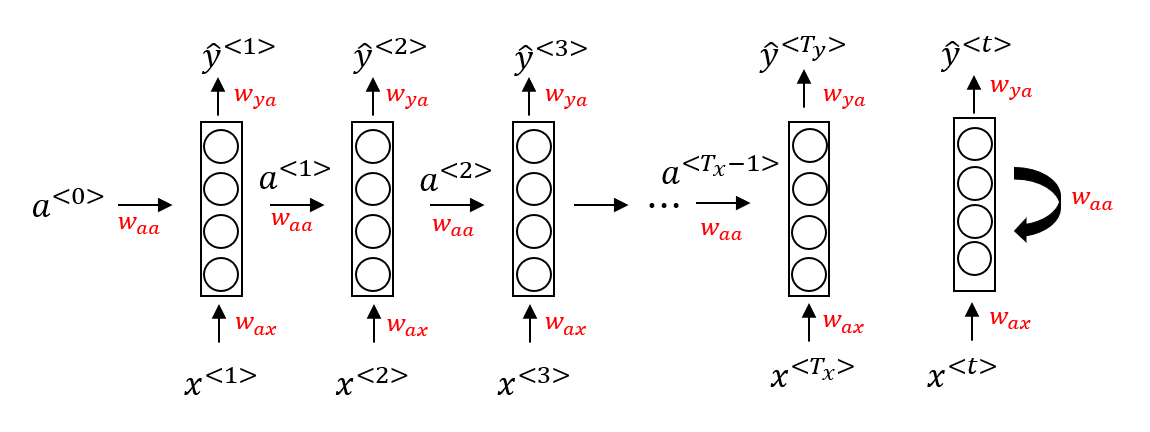
- 我們會先讀第一個單字
- 將他丟入 neural network 產生
- 同時會產生 給下一個單字 使用
- 通常 是一個 0 vector
- 所以 可以共享資訊給 來產生 \hat{y}_^{<3>}
- 這個模型無法由 3 供應資訊給 1
- 之後會談到雙向的 RNNs (Bidirectional RNNs)
- 所有的 neural networks 會共享三大參數
- 命名的規則 (已 ax 為例) : 跟 x 作用並產生 a
- 以一般化 來解釋每個單字在網路中的 forward propogation
- 第一個 activation function 可選擇 tanh 或 ReLU
- 第二個 activation function 可選擇 sigmoid 或 softmax
Simplify Forward Propogation
- 為了講解之後較複雜的 RNNs,我們可以將 forward propogation 進一步簡化
- 將 Waa 和 Wax 合併為 Wa
- 若 Waa 是一個 100*100 矩陣
- 且 Wax 是一個 100*10000 矩陣
- 那麼 Wa 就是 100*10100 的寬矩陣
- 將 和 也合併起來
- 若 a 是一個 100*1 向量
- 且 x 是一個 10000*1 向量
- 那麼合併後就是一個長為 10100*1 的向量
- 新的 forward propogation 公式
Backpropogation through time
- RNNs 的 backpropogation 又稱作 backpropogation through time
- 因為由右至左推回來,像是時間逆流的感覺
- 要計算 backpropogation 之前,要先知道每個單字的 loss function
- 這邊使用 Cross-entropy loss 作為每個單字 (或說時間點) 的 loss function
- 也就是在 時的 loss 表示為
- 而整體的 loss function 可以定義為
- 如此一來,就可以回推並更新
Different types of RNNs
- 剛剛的網路建立在 的狀況下
- 如果要達成各式不同的 input/output 勢必需要不同的網路形式
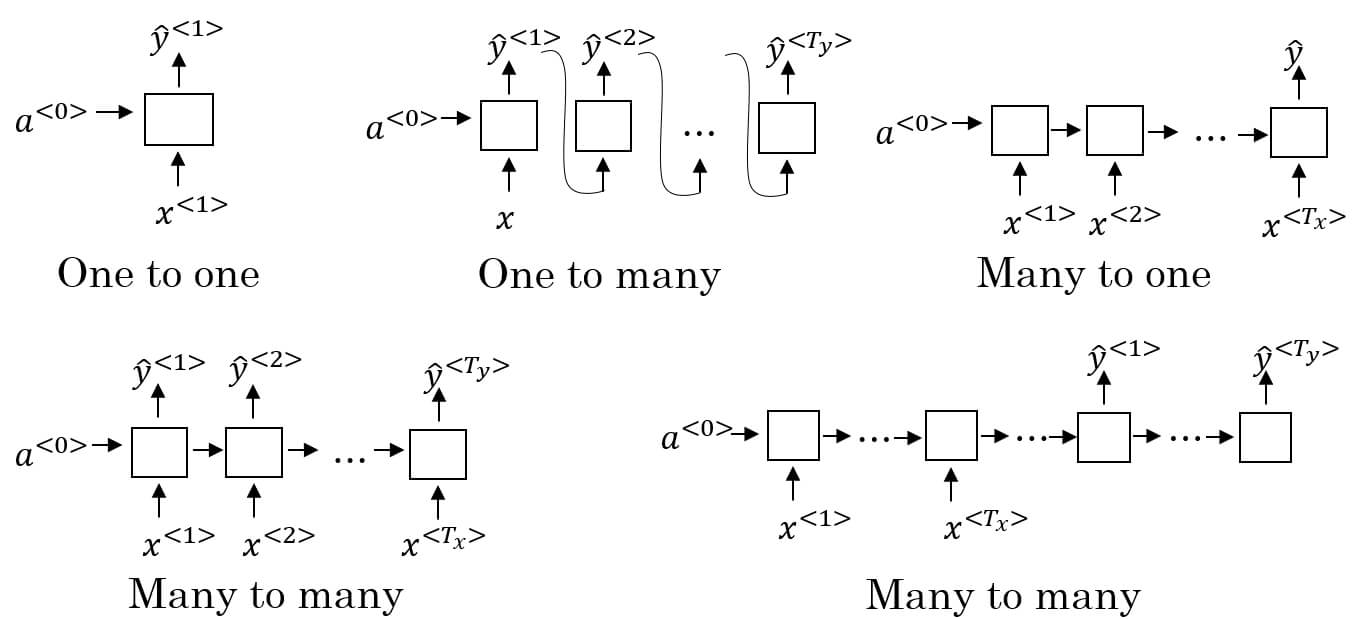
- One-to-One
- 很無聊,就是個普通的神經網路
- One-to-Many
- 用於 sequence generation
- e.g. music generation
- 給定音樂種類,生產出一系列的音符
- 要注意的是該種類會把 當作下一層的 input
- Many-to-One
- 用於 sentiment classification
- e.g. 電影評價打分數
- 讀入一連串的評價,產出 1~5 的分數
- Many-to-many with same length
- e.g. name entity recognition
- 給定一串文字,標示出文字為名稱的部分
- e.g. name entity recognition
- Many-to-many with different length
- e.g. machine translation
- 給定一串英文,翻譯成長度不同的中文
- 首先先讀取 x 的部分,最後再處理 y 的部分
- e.g. machine translation
Language model and sequence generation
Language Modelling
- 假設 speech recognition 時聽到了一句話
- “The apple and pear salad.”
- 那到底是聽到上面的句子還是 “The apple and pair salad.” ?
- 為了判斷是哪一句話,所以給兩句話機率的方法就是 language modelling
- 可以看到在這個 language model 中
- The apple and pear salad 的機率比較高
Build Language model with RNNs
- training set 會是 large corpus of english text
- corpus 是一個 NLP 名詞,代表大量句子所組成的文本
- 首先要 tokenize corpus 中的所有單字,也就是建立字典
- 標點符號可以 tokenize 可以不要
tokenize 前有時會增加一個
<EOS>代表句子結束tokenize 會將每一個單字轉換為 one hot vector
- 假設有一個 10000 單字的字典,那就會在該單字的 index 設 1 其他設 0
- 今天遇到一個不在字典的單字,例如
Mau- 那就會將他設定在
<UNK>的位置,表示 unknown
- 那就會將他設定在
Tokenize 後就可以將他們 input 到 RNN 訓練
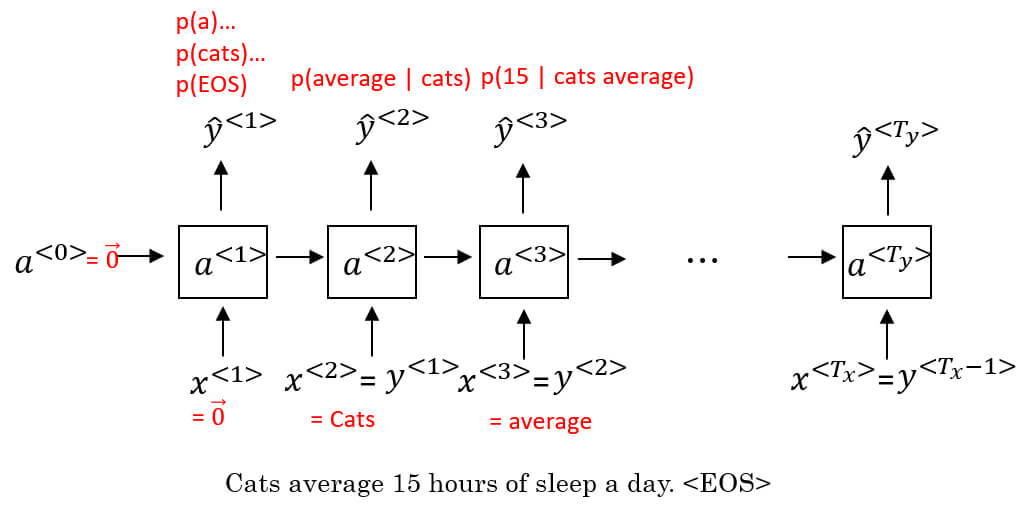
首先 和 都設為 0
第一個 timestep 算出的 代表字典中所有單字是句子中第一個字的機率
- 有 10002 個字,包括
EOS和UNK
- 有 10002 個字,包括
第二個 timestep 的 就是原本句子得到的
- 加上上一個 timestep 算出的
- 所以算出來的 代表出現 cats 後字典裡每一個單字是下一個字的機率
- 所以 average 應該要是最高才對:
以此類推, 表示 cats average 出現後,字典中每個單字的出現機率
為了要訓練這個 RNN 我們定義 cost function
- 在 predict 第 t 個單字時的 softmax loss function 為
- Overall 的 Cost function 為
總結一下,要預測一個句子 的機率
- 等於要計算
- 以及知道 下的 為何
- 再來是 下 為何
Sampling novel sequences
- 訓練好的 language model 可以用 sampling 方式來呈現他所學的結果
- Sampling 方式就像 one-to-many model
- 給定
- 算出 之後,用
np.random.choice方式從中選取任意一個 sample - 這個 sample 作為 繼續算出 再選一個 sample
- 以此類推直到 sampling 到 EOS 或是自訂回合數就停止
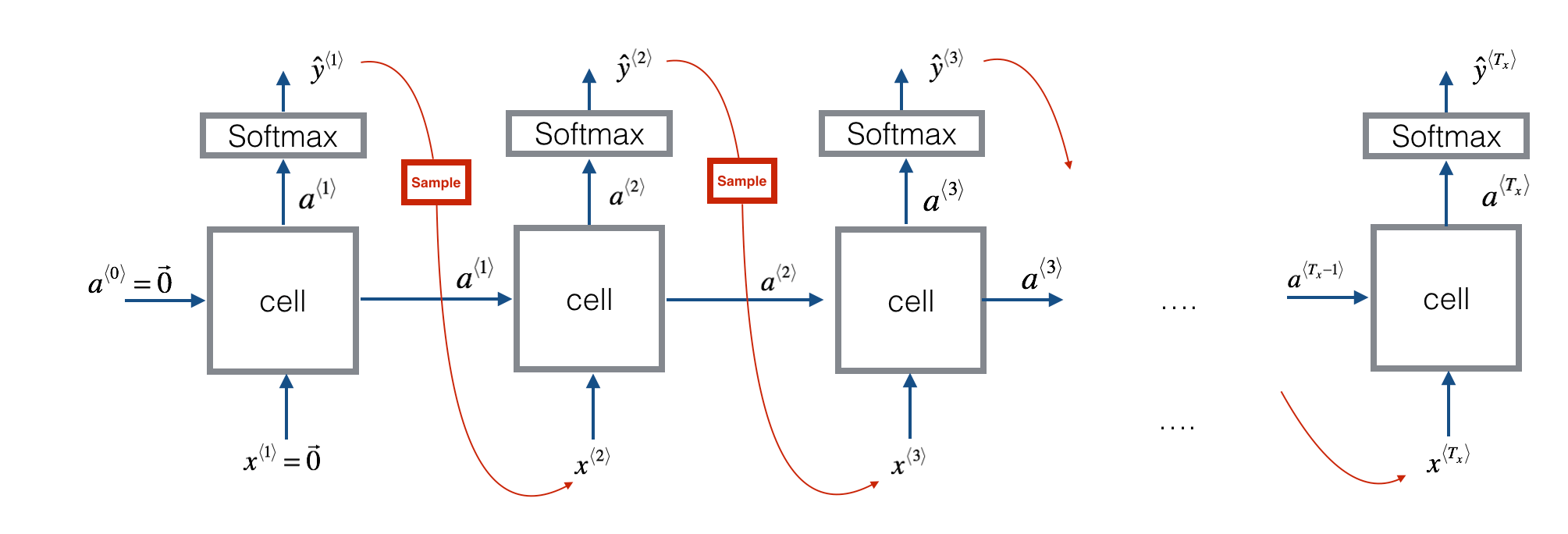
- 以上的方法每個 都是一個單字,稱作 word level model
- 我們可以使用 character 作為每個 inputs
- 可以有大小寫字母、數字、符號
- 優點是不會有
<UNK> - 缺點是資料量變大,計算變大、訓練成本過高
- 不過隨著硬體發展,有一些專案使用 character level model
- Sampling example
- 下圖左是一個從 news 訓練出的 model 所產生的 sampling novel sequences
- 下圖右則是讀完沙士比亞文章所產生的 sequences
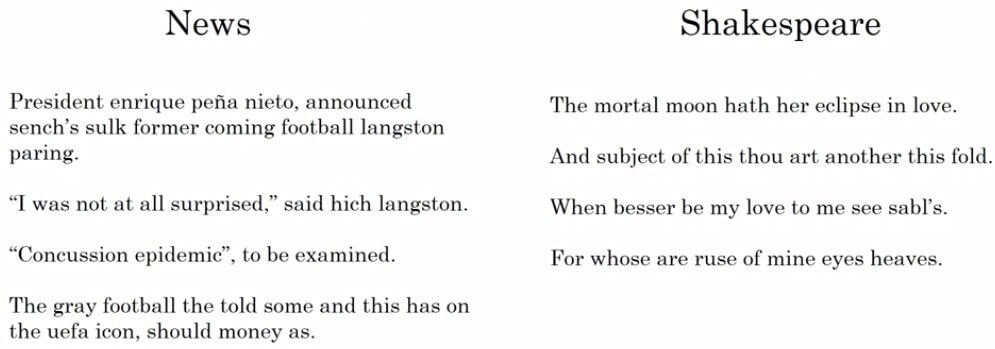
Vanishing gradients with RNNs
- 觀察以下兩句句子
- 人類可以記住非常前面的詞 (cat/cats) 來去判斷很後面的詞 (was/were)
- 但目前的 basic RNN models 很難去找出這種 Long-term Dependencies
- 原因跟 deep neural networks 已提過的 vanishing gradients 有著很大關係
- 回憶一下 vanishing gradients 是因為 backprop 的導數小於 1
- 造成越往回走梯度越小,最終使得梯度消失
Vanishing gradients in RNNs
- RNN 中也有類似 vanishing gradient 的情況,在 RNN 中會出現 local influences
- 舉例來說 只會跟 有較大關係
- 假設 was 在 那他就無法跟最前面的 cat/cats 互相影響了
- 這造成 basic RNN model 有著無法處理 long-term dependencies 的弱點
補充
RNN 也有可能出現 Exploding gradient 但情況較少。而且梯度爆炸比較好偵錯,只要參數有問題或是出現 numerial overflow (出現 NaN) 就會知道,並且可以用 gradient clipping 方法解決 (設定 threshold 避免梯度繼續增高)
- 為了處理 RNN 中的 vanishing gradient,要使用 GRU 及 LSTM 的技術